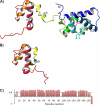Mesencephalic astrocyte-derived neurotrophic factor (MANF) has a unique mechanism to rescue apoptotic neurons
- PMID: 21047780
- PMCID: PMC3024763
- DOI: 10.1074/jbc.M110.146738
Mesencephalic astrocyte-derived neurotrophic factor (MANF) has a unique mechanism to rescue apoptotic neurons
Abstract
Mesencephalic astrocyte-derived neurotrophic factor (MANF) protects neurons and repairs the Parkinson disease-like symptoms in a rat 6-hydroxydopamine model. We show a three-dimensional solution structure of human MANF that differs drastically from other neurotrophic factors. Remarkably, the C-terminal domain of MANF (C-MANF) is homologous to the SAP domain of Ku70, a well known inhibitor of proapoptotic Bax (Bcl-2-associated X protein). Cellular studies confirm that MANF and C-MANF protect neurons intracellularly as efficiently as Ku70.
Figures




Similar articles
-
MANF: a new mesencephalic, astrocyte-derived neurotrophic factor with selectivity for dopaminergic neurons.J Mol Neurosci. 2003 Apr;20(2):173-88. doi: 10.1385/jmn:20:2:173. J Mol Neurosci. 2003. PMID: 12794311
-
Mesencephalic astrocyte-derived neurotrophic factor: A treatment option for parkinson's disease.Front Biosci (Landmark Ed). 2020 Jun 1;25(9):1718-1731. doi: 10.2741/4874. Front Biosci (Landmark Ed). 2020. PMID: 32472754 Review.
-
Upregulation of mesencephalic astrocyte-derived neurotrophic factor in glial cells is associated with ischemia-induced glial activation.J Neuroinflammation. 2012 Nov 23;9:254. doi: 10.1186/1742-2094-9-254. J Neuroinflammation. 2012. PMID: 23173607 Free PMC article.
-
1H, 13C and 15N resonance assignments of the human mesencephalic astrocyte-derived neurotrophic factor.Biomol NMR Assign. 2010 Oct;4(2):215-7. doi: 10.1007/s12104-010-9251-8. Epub 2010 Jul 9. Biomol NMR Assign. 2010. PMID: 20617400
-
Mesencephalic astrocyte-derived neurotrophic factor and cerebral dopamine neurotrophic factor: New endoplasmic reticulum stress response proteins.Eur J Pharmacol. 2015 Mar 5;750:118-22. doi: 10.1016/j.ejphar.2015.01.016. Epub 2015 Jan 28. Eur J Pharmacol. 2015. PMID: 25637781 Review.
Cited by
-
The Solution Structure and Dynamics of Full-length Human Cerebral Dopamine Neurotrophic Factor and Its Neuroprotective Role against α-Synuclein Oligomers.J Biol Chem. 2015 Aug 14;290(33):20527-40. doi: 10.1074/jbc.M115.662254. Epub 2015 Jul 6. J Biol Chem. 2015. PMID: 26149686 Free PMC article.
-
Emerging Roles for Mesencephalic Astrocyte-Derived Neurotrophic Factor (MANF) in Pancreatic Beta Cells and Diabetes.Front Physiol. 2018 Oct 16;9:1457. doi: 10.3389/fphys.2018.01457. eCollection 2018. Front Physiol. 2018. PMID: 30386256 Free PMC article. Review.
-
Mesencephalic Astrocyte-Derived Neurotrophic Factor (MANF) Elevates Stimulus-Evoked Release of Dopamine in Freely-Moving Rats.Mol Neurobiol. 2018 Aug;55(8):6755-6768. doi: 10.1007/s12035-018-0872-8. Epub 2018 Jan 18. Mol Neurobiol. 2018. PMID: 29349573 Free PMC article.
-
MANF is indispensable for the proliferation and survival of pancreatic β cells.Cell Rep. 2014 Apr 24;7(2):366-375. doi: 10.1016/j.celrep.2014.03.023. Epub 2014 Apr 13. Cell Rep. 2014. PMID: 24726366 Free PMC article.
-
MANF antagonizes nucleotide exchange by the endoplasmic reticulum chaperone BiP.Nat Commun. 2019 Feb 1;10(1):541. doi: 10.1038/s41467-019-08450-4. Nat Commun. 2019. PMID: 30710085 Free PMC article.
References
-
- Dauer W., Przedborski S. (2003) Neuron 39, 889–909 - PubMed
Publication types
MeSH terms
Substances
Associated data
- Actions
- Actions
LinkOut - more resources
Full Text Sources
Other Literature Sources
Research Materials
Miscellaneous

